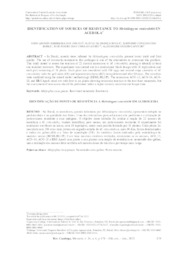Identification of sources of resistance to Meloidogyne enterolobii in acerola.
Identification of sources of resistance to Meloidogyne enterolobii in acerola.
Author(s): SANTOS, J. L. F. dos; SOUZA, F. de F.; BOREL, J. C.; CASTRO, J. M. da C. e; CAPUCHO, A. S.
Summary: In Brazil, acerola trees infested by Meloidogyne enterolobii present lower yield and fruit quality. The use of rootstocks resistant to this pathogen is one of the alternatives to overcome this problem. This study aimed to assess the reaction of 22 acerola accessions to M. enterolobii, aiming to identify at least one resistant rootstock. The experiment was carried out in a randomized block design with 10 replications and each plot consisting of 10 plants. Each plant was inoculated with 350 eggs and second-stage juveniles of M. enterolobii, with the gall index (GI) and reproduction factor (RF) being determined after 90 days. The variables were analyzed using the mixed model methodology (REML/BLUP). The accessions ACO-13, ACO-14, ACO- 18, and BRS Apodi stood out with four to six plants showing resistance reaction to the root-knot nematode, but the assessment of accessions should be performed under a higher density inoculum and longer time
Publication year: 2021
Types of publication: Journal article
Unit: Embrapa Semi-arid Region
Observation
Some of Embrapa's publications are published as ePub files. To read them, use or download one of the following free software options to your computer or mobile device. Android: Google Play Books; IOS: iBooks; Windows and Linux: Calibre.
Access other publications
Access the Agricultural Research Database (BDPA) to consult Embrapa's full library collection and records.
Visit Embrapa Bookstore to purchase books and other publications sold by Embrapa.

